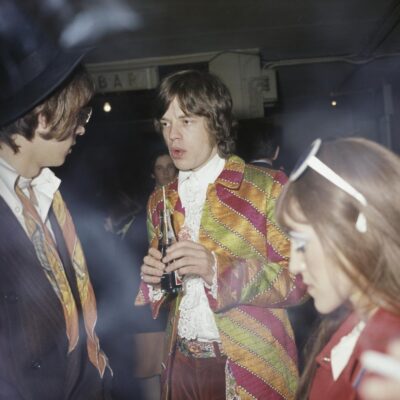
Fashion & History 15.04.2025
17.03.2019
1970sEuropean fashion
The image shows a cloak designed by Yves Saint Laurent in 1970. The design is inspired by Berber and Moroccan traditions, which greatly fascinated Saint Laurent.
At first glance, the semi circular cut and peaked hood with fringed tassels this cloak could be of a study selection of ethnographic dress. However, upon closer inspection, it turns out that this garment was created in the shadow of the Eiffel tower, by none other than Yves Saint Laurent. This garment is definitely a result of Yves Saint Laurent’s fascination with Morocco.
Cloaks and capes can be traced throughout Yves Saint Laurent’s collections, acting as a canvas to different inspirations. The fringes adorning this cape are a typical emblem of Morocco. The Moroccan cloak offers a glimpse inside the Maghreb culture that surrounded Yves Saint Laurent throughout his life, from his childhood in Algeria to his adult life in Marrakech and Paris.
Arriving in the North African country in the late sixties, Yves Saint Laurent and partner Pierre Bergé enjoyed its rich culture, its traditions and liberal mindsets. Together with his childhood in Algeria, Yves Saint Laurent’s stay in Morocco and experience with Maghreb culture heavily influenced his designs.
Saint Laurent and Bergé purchased their first own Moroccan property in 1967. Located in the historic medina of Marrakech, ‘dar el Hanch’ – meaning the House of the Serpent – offered ample space for the pair’s growing collection of traditional Berber art. Seven years later, the pair chose interior designer Bill Willis to turn ‘dar es Saada’, a house bordering the garden of painter Jacques Majorelle, into their new home. His combination of influences is similar to Yves Saint Laurent’s interpretation of far flung cultures for the Parisian catwalks. After Bergé and Saint Laurent moved into Majorelle’s former studio, interior designer Jacqueline Froissac updated the house to accommodate the designer’s guests. The rooms were decorated with dark woodcarvings, stencils and tapestries in ornate gold tones opposed to 1930s furniture. Other rooms used colours found in Matisse’s modern masterpieces.
Throughout their changes of homes, Bergé and Saint Laurent invested in traditional Berber art and this together with his North-African surroundings has strongly influenced Yves Saint Laurent’s signature style, exemplified by the cape illustrating this post.